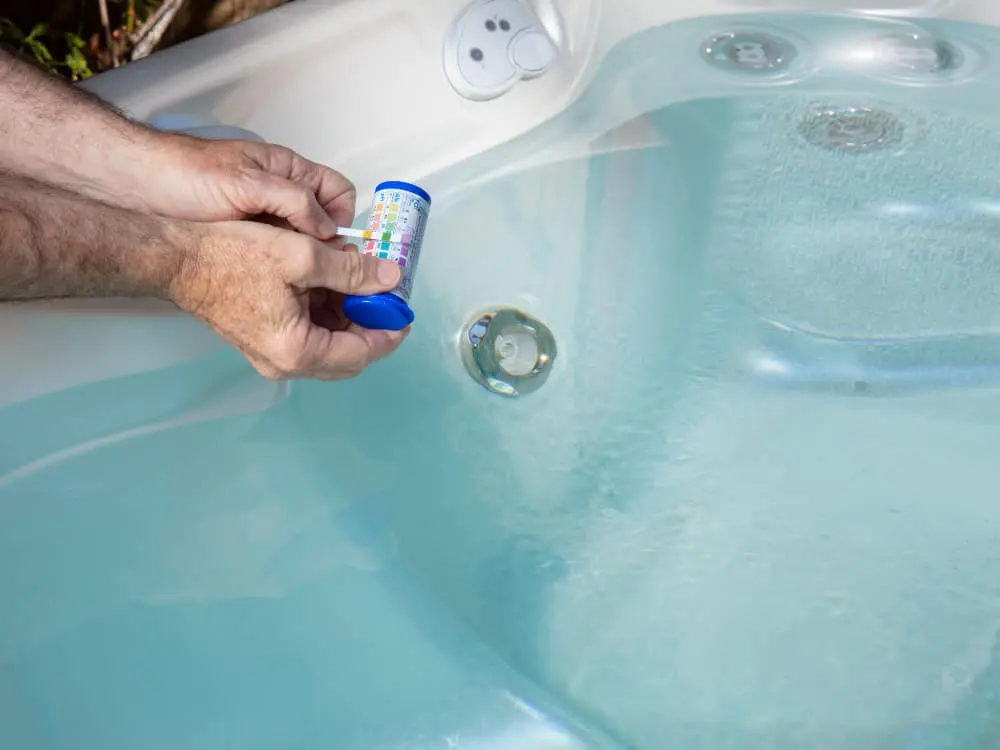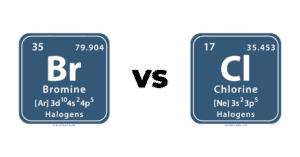If a hot tub has too much chlorine it can not only damage the unit…

Bromine vs Chlorine: Which One is Best for Your Hot Tub?
Wondering about the difference between bromine and chlorine for your hot tub? Explore the key distinctions and find the perfect sanitizer for your needs.
Whether you’re a proud hot tub owner or planning to get one soon, keeping your hot tub clean and safe is a top priority. Both bromine and chlorine are popular choices for sanitizing hot tubs, but the debate of bromine vs chlorine leaves many wondering: which is better? Each has unique strengths, and understanding the difference between bromine and chlorine can help you choose the right one for your needs.
In this guide, we’ll compare chlorine vs bromine, explore their pros and cons, and answer common questions like “Is bromine safer than chlorine?” and “Can you mix chlorine and bromine in a hot tub?” Let’s dive in to ensure your hot tub stays a relaxing retreat!
Why Hot Tub Sanitation Matters
Hot tubs are loved for relaxation and health benefits. Here’s why people use them:
- Sleep Aid: 33.3% of owners soak at night to improve sleep, as the warm water raises body temperature, followed by a cooling drop that signals rest.
- Muscle Recovery: 49% use hot tubs post-workout to ease soreness with warm water therapy.
- Injury Relief: 20% rely on hydrotherapy for targeted pain relief.
Yet, the warm, moist environment of a hot tub is a breeding ground for bacteria and mold if not sanitized properly. Choosing between bromine or chlorine ensures your soak remains safe and enjoyable—no health risks required.

Quick Comparison: Chlorine vs Bromine at a Glance
If you’re wondering what’s the difference between chlorine and bromine, this table offers a quick snapshot to help you compare chlorine versus bromine. It covers the essentials to guide your decision on which sanitizer suits your hot tub best.
| Feature | Chlorine | Bromine |
|---|---|---|
| Chemical Action | Fast-acting oxidizer | Slower ionizer |
| Stability in Heat | Breaks down quickly | Highly stable |
| Skin/Eye Impact | Can irritate | Gentler, less irritation |
| Odor | Strong chemical smell | Milder, less noticeable |
| Cost | Generally cheaper | More expensive |
| Availability | Widely available | Less common, specialty stores |
Bromine vs Chlorine: Key Differences

Understanding what is the difference between bromine and chlorine is crucial for choosing the right sanitizer. While both keep your hot tub free of bacteria and algae, they work differently. Chlorine is a fast-acting oxidizer, quickly killing contaminants but breaking down under high temperatures. Bromine, a slower ionizer, remains stable in the warm water of hot tubs and spas, offering longer-lasting protection. Chlorine’s strong chemical smell can be off-putting, while bromine’s milder odor is less noticeable. However, bromine is pricier and less widely available, which may influence your choice for a bromine vs chlorine spa setup.
Who Should Choose Bromine or Chlorine?
Deciding between chlorine or bromine depends on your preferences and hot tub usage. If you prioritize cost and availability, chlorine is ideal, especially for occasional soakers. Its fast action suits hot tubs used sporadically. Bromine is better for frequent users or those with sensitive skin, as it’s gentler and maintains effectiveness in high heat, making it a top pick for bromine vs chlorine spa maintenance. If you own a swim spa, bromine’s stability may be advantageous for consistent water quality during extended use.
Which is Better: Bromine or Chlorine for Your Hot Tub?
So, which is better, chlorine or bromine? There’s no one-size-fits-all answer. Chlorine excels for budget-conscious owners who want quick sanitation and don’t mind a stronger odor. Bromine shines for those seeking a gentler, low-maintenance option, especially in high-temperature environments like hot tubs or swim spas. Consider your budget, skin sensitivity, and how often you use your spa. Testing both sanitizers over a few months can help you decide what’s the difference between chlorine and bromine for your specific needs.
Pros and Cons: Bromine vs Chlorine for Hot Tubs
| Sanitizer | Pros | Cons |
|---|---|---|
| Chlorine | Cost-effective, widely available, fast-acting | Strong odor, irritates skin/eyes, less stable in heat |
| Bromine | Gentle on skin, stable in heat, milder odor | More expensive, harder to find, slower action |
Switching or Mixing: Bromine and Chlorine in Hot Tubs
Can you use bromine and chlorine in a hot tub together? Mixing them is not recommended, as they can react and reduce effectiveness, potentially causing water imbalance. If you want to switch from chlorine to bromine (or vice versa), drain and clean your hot tub thoroughly to avoid chemical interactions. For example, switching to bromine after using chlorine requires a full water change to ensure bromine’s ionized action isn’t disrupted. Always consult your hot tub manual or a professional before making changes to your bromine versus chlorine setup.
Is Bromine Dangerous? Safety Considerations
Many hot tub owners ask, “Is bromine dangerous?” when considering it as a sanitizer. Both bromine and chlorine are safe when used correctly, but improper handling can pose risks. Bromine is generally gentler on skin and eyes, making it a preferred choice for those with sensitivities. However, overexposure to bromine, such as inhaling fumes from concentrated products or using too much in your spa, can cause respiratory irritation or skin discomfort. Always follow manufacturer guidelines, typically maintaining bromine levels between 3–5 ppm, and store chemicals securely away from children and pets. By test water regularly and using bromine as directed, you can enjoy a safe, relaxing soak without worry.
How Bromine and Chlorine Keep Your Hot Tub Clean
Both bromine and chlorine sanitize by eliminating bacteria, algae, and organic matter. Chlorine oxidizes contaminants rapidly, breaking them down but losing potency in hot water. Bromine ionizes, forming bromamines that continue to sanitize even after initial use, making it effective for hot tubs and swim spas. Regular testing (1–2 times weekly) ensures levels stay within safe ranges: 1–3 ppm for chlorine and 3–5 ppm for bromine. This keeps your water crystal clear and safe for soaking.
Safety Tips for Bromine and Chlorine Use
- Test Regularly: Use test strips to monitor sanitizer levels and pH (7.2–7.8) weekly.
- Store Safely: Keep chemicals in a cool, dry place, out of reach of children.
- Add Gradually: Add sanitizers slowly to avoid spikes that irritate skin or damage equipment.
- Shower Before Soaking: Rinse off lotions or sweat to reduce chemical demand.
Advanced Hot Tub Sanitization Options
Beyond bromine and chlorine, other sanitization options exist. Mineral systems, like those using silver ions, reduce chemical use but require a low level of chlorine or bromine as a backup. Ozone generators break down contaminants but don’t replace sanitizers entirely. UV systems sanitize water as it passes through a light chamber, offering a chemical-free boost. These options can complement your chlorine or bromine routine, especially for sensitive skin or eco-conscious owners.
Bromine vs Chlorine for Hot Tubs vs Swim Spas
For those wondering about bromine vs chlorine spa applications, swim spas present unique considerations due to their larger water volume and frequent use. Here’s how bromine and chlorine compare for both hot tubs and swim spas to help you choose the best sanitizer.
| Feature | Hot Tubs (Chlorine) | Hot Tubs (Bromine) | Swim Spas (Chlorine) | Swim Spas (Bromine) |
|---|---|---|---|---|
| Effectiveness | High, but fades in heat | High, stable in heat | Good, requires more frequent dosing | Excellent, consistent sanitation |
| Maintenance | Weekly checks | Less frequent adjustments | Daily to weekly checks | Weekly checks, stable |
| Cost | Low | Moderate | Moderate (higher volume) | Higher (larger doses) |
| Skin Comfort | May irritate | Gentler | May irritate, diluted effect | Gentler, ideal for long sessions |
Safe Aromatherapy Practices for Hot Tubs
To enjoy aromatherapy without risking your hot tub or health, follow these safe practices:
- Use Hot Tub-Safe Products: Stick to essential oils or aromatherapy products specifically labeled for hot tub use, like those from SpaGuard or Leisure Time.
- Dilute Properly: Add 2–5 drops of essential oil per 100 gallons of water, or follow product instructions, to avoid skin irritation or equipment damage.
- Avoid Overuse: Too much product can lead to foam or residue, so use sparingly and monitor water clarity.
- Clean Filters Regularly: Aromatherapy products can leave residue, so rinse or clean your filters after each use to prevent clogs.
- Test Water Post-Use: Check pH and sanitizer levels after aromatherapy sessions, as oils can disrupt balance, and adjust with appropriate chemicals.
- Drain and Clean Periodically: If you use aromatherapy often, drain and clean your hot tub every 3–4 months to prevent buildup.
Popular Essential Oils for Hot Tub Aromatherapy
Here are some hot tub-safe essential oils and their benefits, perfect for enhancing your aromatherapy experience:
| Essential Oil | Benefits | Best For |
|---|---|---|
| Lavender | Calming, reduces stress | Evening relaxation |
| Eucalyptus | Clears sinuses, boosts energy | Morning or post-workout soaks |
| Peppermint | Refreshes, eases muscle tension | Post-exercise recovery |
| Chamomile | Soothing, promotes sleep | Nighttime soaks |
| Ylang-Ylang | Mood-lifting, romantic | Couples’ spa night |
Note: Always use pure, high-quality essential oils and check for hot tub compatibility. Avoid synthetic fragrances, which can damage your spa.
DIY Aromatherapy Blends for Your Hot Tub
Want to customize your aromatherapy experience? Try these simple DIY blends, ensuring you use hot tub-safe essential oils:
- Relaxation Blend: 3 drops lavender + 2 drops chamomile for a calming soak.
- Energizing Blend: 3 drops eucalyptus + 2 drops peppermint for a refreshing boost.
- Romantic Blend: 2 drops ylang-ylang + 2 drops lavender for a sensual vibe.
Tip: Mix oils in a small glass bottle with a carrier (like a teaspoon of hot tub-safe dispersant) before adding to water to ensure even distribution.
What to Avoid When Using Aromatherapy in Hot Tubs
To protect your hot tub and health, steer clear of these common mistakes:
- Non-Spa Products: Household oils or bath bombs can clog jets or create unsafe water conditions.
- Excessive Amounts: Overloading oils leads to foam, residue, or skin irritation.
- Poor Ventilation: Indoor hot tubs need good airflow to prevent inhaling concentrated vapors.
- Ignoring Maintenance: Skipping filter cleaning or water testing after aromatherapy can cause long-term damage.
Frequently Asked Questions About Hot Tub Aromatherapy
Can I Use Regular Essential Oils in My Hot Tub?
No, only use essential oils labeled as hot tub-safe. Regular oils may contain additives that damage your spa or disrupt water chemistry.
How Often Can I Use Aromatherapy in My Hot Tub?
Use aromatherapy 1–2 times per week, ensuring you clean filters and test water after each session to maintain balance.
Will Aromatherapy Damage My Hot Tub?
Not if you use hot tub-safe products, dilute properly, and maintain your spa. Improper use can clog filters or affect water quality.
Can Aromatherapy Affect Hot Tub Water Chemistry?
Yes, oils can alter pH or sanitizer levels. Always test and adjust water chemistry after using aromatherapy products.
Frequently Asked Questions: Bromine or Chlorine
What’s the difference between chlorine and bromine?
Chlorine is a fast-acting oxidizer that breaks down quickly in hot water, while bromine is a slower ionizer, more stable in heat with a milder odor. Chlorine is cheaper and widely available, but bromine is gentler on skin.
Is bromine better than chlorine?
Bromine is better for frequent hot tub users, those with sensitive skin, or swim spa owners due to its heat stability and gentleness. Chlorine suits budget-conscious users or occasional soakers.
Can you use bromine and chlorine in a hot tub?
Mixing bromine and chlorine is not advised, as they can react and lose effectiveness. To switch between them, drain and clean your hot tub to avoid chemical conflicts.
Is bromine dangerous for hot tubs?
Bromine is safe when used properly, maintaining levels of 3–5 ppm. Overuse or improper storage can cause skin or respiratory irritation, so follow guidelines and test water regularly.
Final Thoughts on Bromine vs Chlorine and Aromatherapy
Choosing between bromine or chlorine for your hot tub or swim spa depends on your budget, skin sensitivity, and usage habits. Bromine offers gentle, stable sanitation, ideal for frequent soakers or swim spa owners, while chlorine provides cost-effective, fast-acting cleaning for occasional use. Neither is inherently better—it’s about what suits your needs. Aromatherapy, while not a sanitizer, can enhance your hot tub experience with relaxation or energy boosts, but always use hot tub-safe oils to avoid damaging your spa. For personalized advice or sanitizer products, visit Epic Hot Tubs or consult with their experts.

Richard Horvath
Richard has been in the hot tub & spa industry for years. As a long hot tub & swim spa owner himself, Richard has a passion for helping homeowners create their dream backyard.



